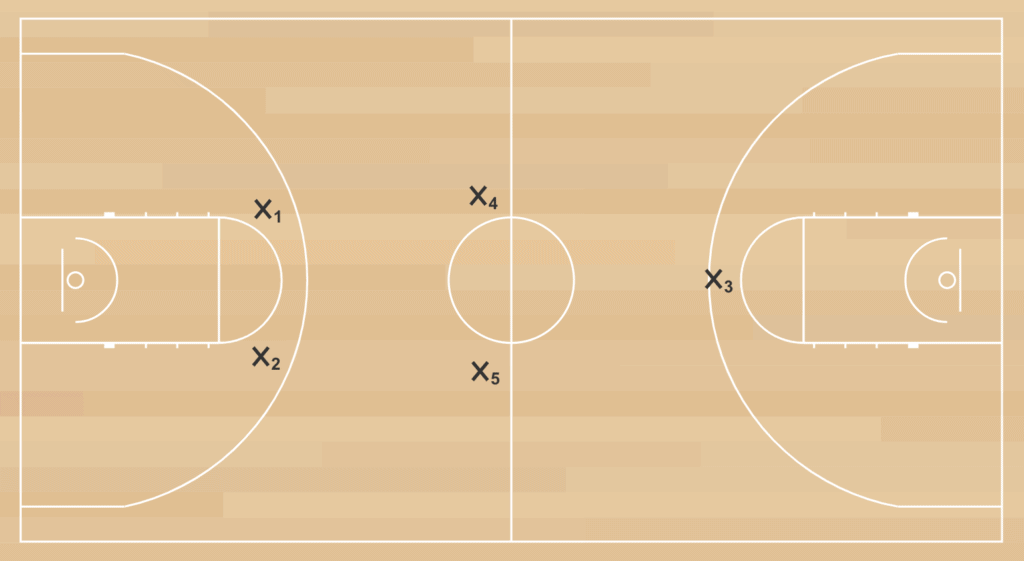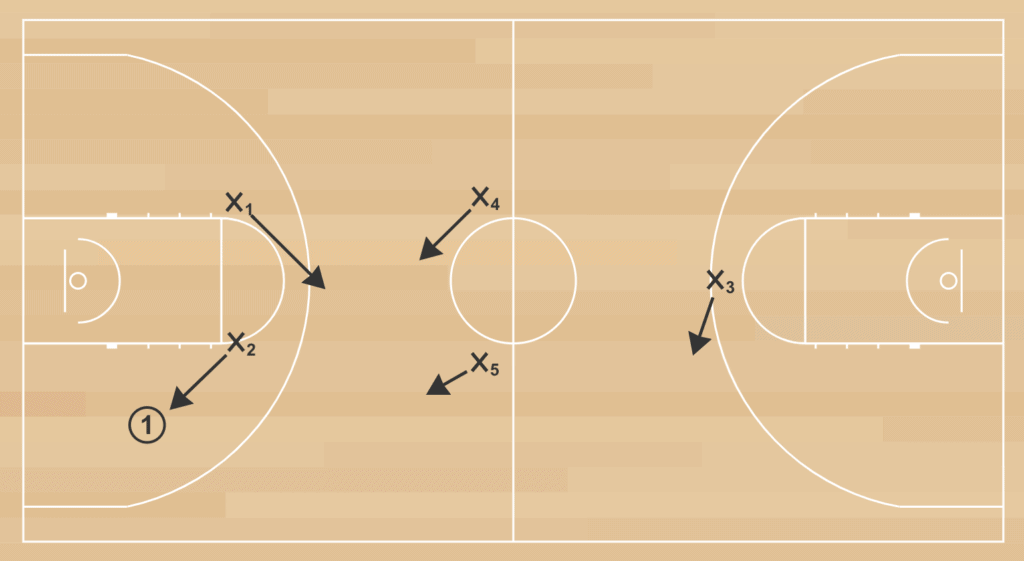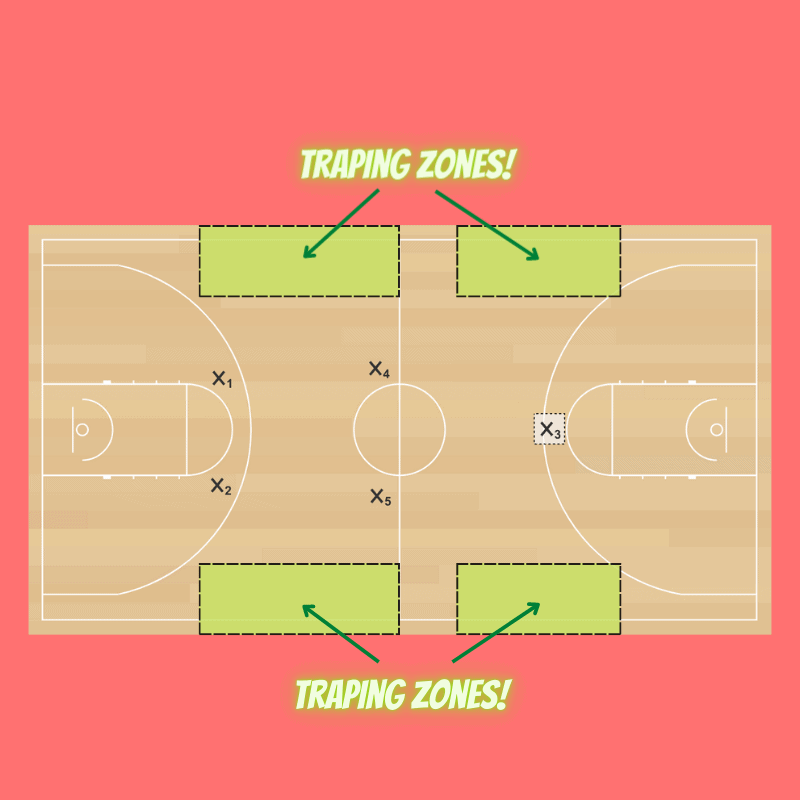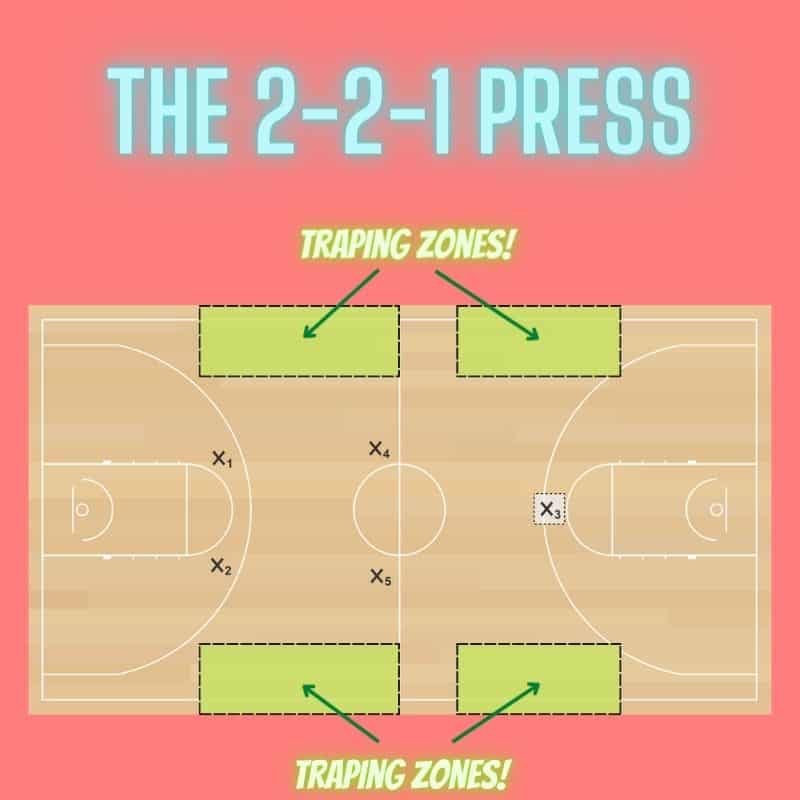The 2-2-1 press is a defensive strategy in basketball. It’s designed to apply on-ball pressure and force turnovers. The 2-2-1 press is most often deployed in a 3/4 court format but there is a common half-court version with some minor adjustments.
Let’s be clear, the ultimate goal of a 2-2-1 press is a turnover. You’re pushing your defenders to engage and get that ball handler pinned down against the sideline where they’re forced into a rushed pass. The standard action of this defense is to direct the ball to one side with one of your guards so that a forward can hop out and lay down a trap.
The 2-2-1 press can be an exhausting strategy. But that’s the case with just about any press defense. You’ll want to be sure that your team is ready for this in terms of both athleticism and skill. The rewards can be high, but the risk is up there as well.
If you’re beginning to introduce some pressing strategies into your playbook, the 2-2-1 press can be a great place to start. We’ll cover all of the details below of what this strategy looks like, how and when to deploy it, how it evolved.
As usual, we’ll start with a quick breakdown that should catch you up on the basics. Then we’ll dive progressively deeper into the murky waters of basketball theory. It’s easy to get in the weeds very quickly when discussing basketball strategy. Check out my post on translating basketball defense if you start to get confused.
How the 2-2-1 Press Works
To get an idea of how the 2-2-1 press functions in a game, let’s run through some play. We’ll take a look at the initial formation then step through the rotations to see how this strategy should respond to an advancing offense.
The 2-2-1 Press Formation
Check out the basic 2-2-1 formation…

Your defenders are arranged here like a house, or a rocket, the tip pointing at the defended goal. There are 2 rows of 2 defenders with a trailing defender in the back court. Typically, your guards will make up the front row, with forwards behind them and your center around the basket.
So that’s a half court view of a 2-2-1 zone. For a press you’ll want to stretch that formation across the floor. After all, the point of a press defense is to pester your opponent across the court, not just on one side.
A 3/4 court 2-2-1 press will look more like this. Imagine the offense approaching from the left.

The first two defenders are spaced near the top of the opposing key. The next line of defense rests just behind half-court. The center is posted up out back.
2-2-1 Press Rotation
You don’t get much from just looking at that initial formation. We need to see how it adjusts to an oncoming attack. So let’s cover some common movements.
Imagine the opposing ball handler moves in. You’re not typically pressuring the inbound pass here. You’re more focused on setting up. So they should get to around the free throw line before meeting with much resistance.
Those 2 highest defenders greet the oncoming ball handler. They work together to pressure the ball towards either sideline. The ball side defender closes out. The opposite defender drops in, cutting off passing to the middle. It’s crucial with this strategy to keep the ball out of the middle of the court.

As the offense advances, the next line of defense moves in. The ball-side secondary defender moves towards the sideline, preparing to lock into a trap with the on-ball defender. The opposite side moves in to fill the gap they’ve left down the lane.
And then the trap is sprung…

Here you see ① dribbling off to the side with X2 keeping them contained. X5 is slipping in to lock down the trap. X1 and X4 are moving down the court to maintain coverage in that center lane. Again, you don’t want passes going into the center of the court, so we’re working to cut out that option.
If we’re doing our job here, the path of least resistance is a pass down the sideline. In that case we’re still prepared for a second trap down court. Let’s say the initial trap gets broken with a sideline pass like the one outlined below from ① to ④.

X3 should move quickly to cut off forward progress while X5 jumps to pressure the ball handler away from the middle of the court. X2 cuts into the gap left by X3. X4 slides to meet the ball, leaving some space in the paint that should get filled by X1.
Mirroring this to the opposite side, you can see that the 2-2-1 press has the goal of creating traps on the sidelines before and after the half-court line.

If all goes to plan, the offense should be trapped up against the sidelines and forced into unreasonable shooting or passing attempts and turnovers. This movement can also slow down penetration. The approaching guard should find enough resistance to that by the time they figure out how to move into scoring territory, they’re up against the shot clock.
How to Use the 2-2-1 Press
A lot of the strategy here can be boiled down to some simple guiding principles. Force the ball towards the sidelines. Keep it out of the middle.
You’ll start to recognize this as a pattern as you dive into the various forms of press defense, and ultimately basketball defense in general. Strategies will frequently seek to divert the ball away from the center of the court. Off-ball defenders will often be directed to adjust towards the ball-side as the offense approaches.
So you could argue that this is a central tenet of basketball defense in general, but it is particularly important in the 2-2-1 press. That sideline serves here as an extra defender, but you’re still executing a double team, so effective movement into the center lane can catch you empty handed.
As the ball is hopefully diverted to one side, the front defender on that side will begin to tighten up on the the ball handler, encouraging them further towards the sideline. As the ball moves across half-court, the second defender on the ball-side should begin to initiate the trap.
The 2 defenders on the opposite side should also be moving towards the ball, but they should be vigilant to not cross the center court line, maintaining some spacing and clogging up ball movement into the center lane.
The backcourt defender is likely being split across multiple offensive players. They should be keeping a close eye on the ball handler to cut off any floating passes over the press and into the backcourt.
One of the coolest rotations we can work in here can be deployed when the offense sends a pass backcourt. In this case you can send the secondary defensive line forward. The first defender, who was initially playing on-ball, can stick with their matchup, while the secondary defender closes out on the new ball handler.
What is the purpose of a 2-2-1 press?
The purpose of the 2-2-1 press is not only to create turnovers, but also to slow down the opposing team’s offense and force them into making rushed decisions. This makes it an effective tactic for teams looking to regain control of the game or maintain their lead in the final minutes of a game.
When to use the 2-2-1 Press
A weak point guard is one of the biggest indications that a 2-2-1 press may be effective. Due to its tendency to setup a double team on the ball handler right out of the gate, the 2-2-1 press can be kryptonite against a Point Guard who is not able to maneuver themselves out of trouble.
This action can also serve to shift the scales when the scoreboard is running the wrong way against you. Falling into the broader categories of ‘press’ and ‘trap’ defenses, the 2-2-1 press should be effective in forcing turnovers and speeding up play. It’s the type of strategy that may give up some easy buckets, but it can also give you a chance at making those game changing plays that turn the odds in your favor.
How to Beat a 2-2-1 press
A great point guard can render the 2-2-1 press ineffective. If they can see this type of thing coming and dribble or pass their way out of it efficiently, it’s just going to wear your defense down.
Simple enough, but you’re not always going to have an elite point guard on your squad. If that sounds like you, consider taking advantage of the open corners.
While defenders are concentrated at the side and down the center, the deep corners are vulnerable. A classic horns strategy tends to set you up for this type of action if you can implement it. Run your best shooters into those corners and use screens to get some access to the center lane. If you can create shot attempts at the corners, you’re also likely to find multiple attempts unless the defending center is a strong rebounder, given that spacing is not likely to be condensed around the basket.
You also will often find yourself with a significant advantage in the backcourt where one defender is guarding a wide swath of land. Just one extra player in the backcourt while the ball handler is being double teamed can open up enough space on the floor to invite a successful pass, deep into enemy territory with the numbers advantage.
The History of the 2-2-1 Press
In the early 1900’s, Coach Cam Henderson was starting out his career coaching High School basketball in a little town in West Virginia. The newly constructed court and gymnasium were improperly cured, leading to a leaky roof and often a wet court. Henderson evolved a strategy that limited his players to certain regions of the floor in order to avoid slipping and injuries. This resulted in the 2-3 zone defense.
Various permutations of the zone strategy evolved from this initial concept. Considering the strong similarities in alignment between the 2-3 and the 2-2-1, it wouldn’t have taken long to experiment with shifting the forwards and guards up away from the basket. And it would likely have quickly evolved that you could spread this formation across the floor. The resulting increase in traps and turnovers would likely have spoken highly.
What are Some Similar Defensive Strategies to the 2-2-1 Press?
The 2-2-1 half-court press is quite similar. Often, as the full 2-2-1 is squeezed down, it will effectively evolve into its half-court counterpart. Both formations can look very similar to the classic 2-3 zone, just shifted slightly, the rotations are what sets the 2-2-1 apart however, and the end goal is quite different. In terms of rotation, this strategy will look more like other trapping presses, particularly the 1-2-2 full court press.
